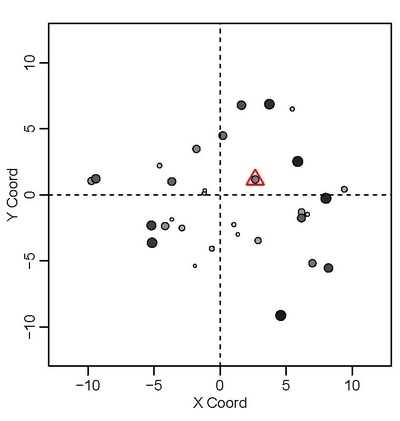|
Today’s tree has the #5 painted on its trunk in bright blue paint (outlined here in yellow). You can’t tell by looking at it, but after growing well in the 1980’s and 90’s, its growth plummeted in 2001. What happened? This paper birch (Betula papyrifera) lives on a research plot in the Superior National Forest in Minnesota, a very cold part of the country. Paper birch has smooth, white bark that peels off in strips. Because of this unique bark it’s very recognizable. This paper birch grows in a forest that is a mix of trees that lose their leaves every fall (called deciduous trees) and evergreen trees that keep their needles all year round (coniferous trees). Tree 5 is one of our study subjects. We sampled it by extracting a long skinny core out of its trunk to measure its tree rings. We also measured the diameter of its trunk and mapped its location within a circle with a radius of 11 meters. You can see other numbered trees in the background that were measured in the circle (called a plot). Those trees are neighbors of tree 5, and to some extent they compete for resources like sunlight, water and nutrients from the soil. Here’s a map of this plot from a point of view above the canopy. Tree 5 has a red triangle around its location. The photo at the top was taken from the center looking east (to the right). We measured these trees because we want to know how the forest is growing to help forest managers monitor forest health and make plans for the future. We use the tree rings to look back in time and see the growth of each tree since its start as a sapling 50, 100 or even 300 years ago! We carefully measure the width of the tree ring for each year, then we use some calculations to figure out the weight (or mass) of all the wood that grew over the stem and branches. Mass is a good measure to tell us how well a tree is growing in comparison to its neighbors. Once we’ve done our calculations we can make a growth chart for the life of tree 5.
What does tree 5’s growth chart tell us about its life and the surrounding forest? For starters, it didn’t grow much in its 1st 20 years, but around 1980 it started growing a lot more wood. It went from producing 1-2 kg of wood each year, to as much as 13 kg in the early 1990’s! Most of its neighbors started growing around the same time, so we can conclude that some event around 1960 reset the forest and allowed small, young trees to get established. Tree 5 grew fast enough to claim a spot in the new forest canopy. Then, in 2001, tree 5’s growth crashed, dropping from 10 kg in 2000 all the way down to 1 kg a year later. This big drop could be a mystery, but we actually know there was a caterpillar outbreak in 2001. Forest tent caterpillars were numerous and hungry enough to eat most of the deciduous leaves by early summer. They were feasting, and the trees were experiencing a famine. Paper birch is one of the trees whose leaves taste best to this caterpillar, and tree 5 did not escape damage. We can be extra sure that this is what happened because we have satellite images from the same year to measure changes in the forest canopy. The caterpillar outbreak lasted 2 years, then went away. Now the question is whether tree 5 can bounce back and grow like it used to, or if the damage will be long-lasting. Right now we just have to wait and see!
0 Comments
Leave a Reply. |
AuthorI'm a scientist who studies forests. I often need to measure lots of trees to understand why forests change. I think about trees a lot, and sometimes they just become numbers to me: how tall are they? how many are there? how many boards can you get out of them? Archives
October 2015
Categories |
Proudly powered by Weebly




 RSS Feed
RSS Feed